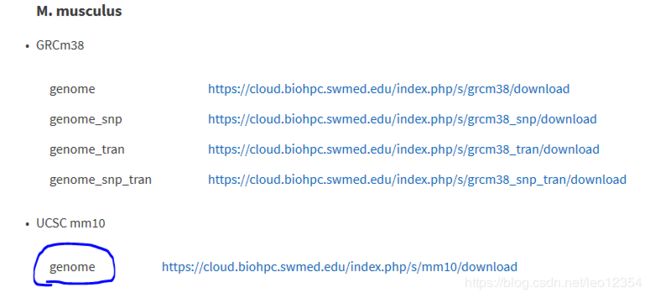RNA-seq(3):学习笔记 序列对比
主要参考网站:
chip详细分析流程
序列比对:Hisat2
1.需要建立一个index文件有两种方法。
为啥要这个index?需要把测序数据和这个参考基因组做对比,但是又不能直接和基因组做对比,不然哪儿跟哪儿可能区分不开,只能拿个简化版的注释文件做对比。
第一种,直接去HISAT2这个网站下载就好了。生信小白就是这么干的。这次采用的是mm10 j基因组,所以下载了这个,但是,wget 方式太慢,又没有迅雷会员,便用IDM软件下载,还算快吧,但也好久了。(15:00 -24:00)


第二种方式,自己下载基因组,自己用Hisat2软件构建index文件,但是我看不懂,更不会自己构建,算了,还是直接下载吧。
# 其实hisat2-buld在运行的时候也会自己寻找exons和splice_sites,但是先做的目的是为了提高运行效率
extract_exons.py gencode.v26lift37.annotation.sorted.gtf > hg19.exons.gtf &
extract_splice_sites.py gencode.v26lift37.annotation.gtf > hg19.splice_sites.gtf &
# 建立index, 必须选项是基因组所在文件路径和输出的前缀
hisat2-build --ss hg19.splice_sites.gtf --exon hg19.exons.gtf genome/hg19/hg19.fa hg19
上述代码参考这个网站
解压:
tar -zxvf *.tar.gz
2.下载index文件的时间,等着也是等着,可以把之前下载的SRA转化为FASTQ格式具体代码可以参考序列比对:Hisat2。
我之前直接下载了FASTQ格式,这一步便省略了。对于我来说,步骤越少越好。
但是接下来,序列对比,有两种思路。
第一种,bowtie2 & samtools
第二种,hisat2 & samttols
上边两个参考网站,分别对应了这两种因为今天没有下载好 genome的index文件,所以具体操作不知道,但是,理论上看,都可以,而且HISAT2 比对速度确实很快,一个样本转录组数据比对 2G 的核糖体 RNA 参考基因组约 25 分钟,bowtie2 需要 170 分钟(线程数都是 4)。因此我决定先按照序列比对:Hisat2第二种方式去做。
代码:
cd /mnt/f/chip_seq/aligned
for ((i=5;i<=9;i++));do hisat2 -t -x /mnt/f/chip_seq/data/reference/index/mm10/genome -U /mnt/f/chip_seq/data/SRR62020${i}.fastq.gz -S SRR62020${i}.sam; done
在对比的过程中,出现了这个错误代码:
Traceback (most recent call last):
File "/home/leo/miniconda3/bin/hisat2_read_statistics.py", line 210, in
reads_stat(args.read_file, args.read_count)
File "/home/leo/miniconda3/bin/hisat2_read_statistics.py", line 168, in reads_stat
for id, seq in fstream:
File "/home/leo/miniconda3/bin/hisat2_read_statistics.py", line 44, in parser_FQ
if line[0] == '@':
IndexError: index out of range
Could not locate a HISAT2 index corresponding to basename "/mnt/f/chip_seq/data/reference/index/mm10/"
后来我仔细看了看,发现是,index定位不准确,没有加上genome 。
/mnt/f/chip_seq/data/reference/index/mm10/genome但是,这些关于index out of range 的错误先不用管。可能是fastq文件里面有一些空格。但这些可以被允许,尽管是错误。
可以参考一下几个网址:
Question: HISAT2: an “IndexError: index out of range”
Index out of range?
Python-IndexError: list index out of range
python 报错不影响hisat2运行
最后的结果:
Traceback (most recent call last):
File "/home/leo/miniconda3/bin/hisat2_read_statistics.py", line 210, in <module>
reads_stat(args.read_file, args.read_count)
File "/home/leo/miniconda3/bin/hisat2_read_statistics.py", line 168, in reads_stat
for id, seq in fstream:
File "/home/leo/miniconda3/bin/hisat2_read_statistics.py", line 44, in parser_FQ
if line[0] == '@':
IndexError: index out of range
Time loading forward index: 00:00:26
Time loading reference: 00:00:04
Multiseed full-index search: 00:27:09
19687027 reads; of these:
19687027 (100.00%) were unpaired; of these:
8549808 (43.43%) aligned 0 times
9537058 (48.44%) aligned exactly 1 time
1600161 (8.13%) aligned >1 times
56.57% overall alignment rate
Time searching: 00:27:13
Overall time: 00:27:39第一个用了27min.
随后对把sam文件转换成bam文件,代码如下:
samtools sort ./SRR620204.sam -o ring1B.bam其实这样做会导致文件量很大,而且内部的数据没有很好的排序,可以如下操作:(当然,我这一次没这么做,直接就按照上边的代码写了下去)
# 首先将比对后的sam文件转换成bam文件
# 利用的是samtools的view选项,参数-S 输入sam文件;参数-b 指定输出的文件为bam;最后重定向写入bam文件
$ cd mnt/f/rna_seq/aligned
$ for ((i=56;i<=62;i++));do samtools view -S SRR35899${i}.sam -b > SRR35899${i}.bam;done
# 将所有的bam文件按默认的染色体位置进行排序
$ for ((i=56;i<=62;i++));do samtools sort SRR35899${i}.bam -o SRR35899${i}_sorted.bam;done
# 将所有的排序文件建立索引,索引文件.bai后缀
$ for ((i=56;i<=62;i++));do samtools index SRR35899${i}_sorted.bam;done**
3.拿到bam文件,应该再进行一次质控**:
具体步骤参考序列比对:Hisat2
另一个关于bam文件加载入IGV和质控的网站。
质控结果如下:(摘自上述 第二个网站)
4.反正上述过程所用的时间很久,可以提前准备R里的软件
如果是ChIP-seq,需要下载 – chipseeker
source ("https://bioconductor.org/biocLite.R")
biocLite("ChIPseeker")
biocLite("TxDb.Mmusculus.UCSC.mm10.knownGene")
然后又是很久。
整个帖子的过程我用了两天下午+晚上做完了。毕竟是新手可能会慢很多